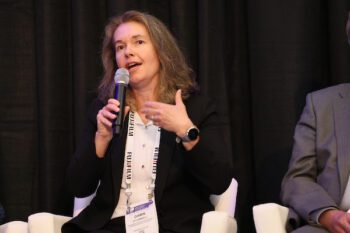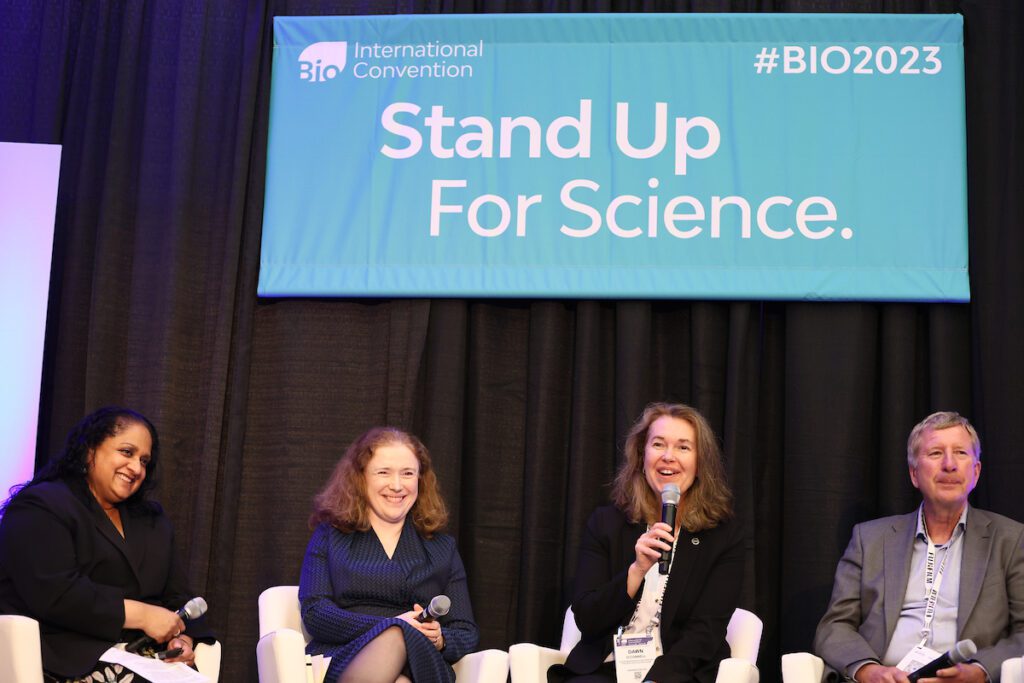“The policy environment is something that a lot of people seem to think is this separate, strange thing that has very little to do with business or with responding to outbreaks, epidemics, and pandemics,” began Asha George, DrPH, Executive Director of the Bipartisan Commission on Biodefense, during the BIO International Convention 2023 panel, Enhancing Public Health Preparedness through Policy and Partnership.
“If you’re going to build a business and develop the next greatest thing that’s going to solve all of the world’s disease-related problems, you need to know what’s going on in policy. Similarly, the policymakers need to know what you’re thinking and what you’re doing.”
The panel discussion brought policy and industry perspectives to the table to discuss not only the lessons learned from past pandemics, but determine exactly what industry, policy, and global partnerships need to do to make sure that the next pandemic is stopped before it becomes destructive.
European and American call for industry partnership
The panelists from each side of the Atlantic were united in their call for industry to join with policymakers and government entities to solve the pandemic preparedness problem.
“We are not going to be prepared in Europe if we don’t look at the world around us. So we need to build cooperation with the rest of the world,” said Pierre Delsaux, Director General of the Health Emergency and Preparedness Response Authority (HERA) European Commission. “As policymakers, we cannot live in isolation. We need to work with industry.”

Dawn O’Connell, the Assistant Secretary for Preparedness and Response (ASPR) at the U.S. Department of Health and Human Services (HHS), echoed Delsaux’s sentiment as she recalled how U.S. entities like Biomedical Advanced Research and Development Authority (BARDA) and ASPR responded to the pandemic. “We really do need a public-private partnership in order for BARDA to be successful. BARDA helps de-risk the technology as it’s coming through. We have a joint interest in the United States to be more prepared and protected from potential future pandemics and pathogens.”
In the U.K., it was pre-COVID, during an early Ebola pandemic, that taught British government-industry coalitions how to respond to a variety of pandemic risks. “CEPI was formed as a result of a really bad EBOLA outbreak and we started with the idea that never again should the world be in such an unprepared state for an infectious disease that is so detrimental to humanity,” said Emma Wheatley, Director of Access and Private Partnerships at Coalition for Epidemic Preparedness Innovations (CEPI).
“For us, partnering with industry is essential,” Wheatley continued. “We’re a coalition. We bring money, expertise, connections, and forward-looking thought—whether it’s about policy, the business models, or social systems. But we still can’t do anything to prepare for pandemics without industry and other partners.”
What are some concrete steps in the U.S.?
In the U.S., discussions of future pandemic preparedness came down to a couple of recurring topics: the upcoming Pandemic and All-Hazards Preparedness Act (PAHPA) reauthorization and shoring up supply chains to make sure that the U.S. and the world never face the same issues of product bottlenecking that we saw during COVID.
“One of the things we saw in those early days of the pandemic was that we didn’t have what we needed,” O’Connell recalled. “Our supply chain was pinched, so we were given a significant amount of supplemental funds to begin investing in onshore and critical domestic manufacturing for those PPE and medical supplies that we weren’t able to get.”
But equally as important to how the U.S. government responded is how it has maintained its systems to be ready in the future. “We have invested $16 billion and over 87 different contracts with industry to begin to build construction and new factories, new facilities, manufacturing lines, to be able to bring some of this capability on shore,” O’Connell said.
O’Connell went on to say, “When given the opportunity to think about the increase in BARDA and ASPR authorities, we certainly could go farther, faster with more of them. And we’re looking at the new PAHPA reauthorization bill to ensure some of that. Some of what we’re looking to improve are our acquisitions authorities and working with industry and being able to procure products as quickly as we need to get them in the research pipeline.”
Addressing vaccine distribution in a federalized system
The U.S. and Europe are no strangers to navigating federalized systems of governance—whether it is the management of 27 member states in Europe or 50 states in the U.S.
“When we had a lot of MPOX cases in Europe,” recalled Delsaux. “A few member states had multiple cases, but most of them did not have multiple cases. What we saw was that some of the big member states wanted to purchase multiple vaccines, and the companies were not able to facilitate them. So, in response, what HERA did as a larger overseeing body was purchase multiple vaccines on behalf of the member states, and then we donated those vaccines to the different members that needed them.”
“HERA is, to a certain extent, the child of the COVID crisis,” said Delsaux. “because during the COVID crisis, member states acted as independent. Yet, addressing the pandemic relied on unity and coordinating that action. Without working together, we simply would not have been able to face a crisis.
Similar issues were seen in the U.S., and there was more than one call for unity when it came to interstate cooperation for future pandemic preparedness.
Industry perspective
The panel concluded with Chris Frech, the Senior Vice President of Global Government Affairs at Emergent BioSolutions, providing a brief industry perspective.
“I think it’s really clear that the public-private partnership is a really important component of tackling these problems,” said Frech. “Governments can’t plan for pandemics on their own. Governments and coalitions that partner with industry, however, can plan for pandemics. But consistency and clarity of purpose are important for future planning so you’re not going from crisis to clarity, only to end with complacency.”
Looking forward
“It’s always easy to say ‘we should have done this’ or ‘we should not have done that,’” said Delsaux. “But it’s only easy to say that after the fact—it’s easy to rewrite history. What’s difficult is for all of us to come together to try to see what the future needs and to try to be prepared for it—and we cannot do it in isolation.”
“There’s been an assumption post-COVID that all outbreaks or pandemics will look the same,” said Wheatley. “I think the one lesson that we’ve actually taken from the COVID pandemic (and others) is that none of these outbreaks are going to look the same. So we have to have to build agile and resilient systems and develop partnerships within those systems to deal with the next public health crisis.”
“It’s a partnership—and a little bit of co-creation,” said O’Connell. “And it’s not just government telling industry what to do or industry coming in with a fully formed idea. We work best when we move forward together through the various phases of development. We rely on industry, and we are grateful for that partnership.”




